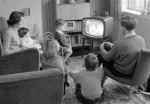 The middle class. The Great MC.
The middle class. The Great MC.
What is it, how is it defined? Is it growing? Shrinking? Is it, more importantly, being exploited by the rich and the powerful to enable their largess?
Is Obama right? Is it true, in fact, that the folks-the “Us”- are being used and manipulated in some grand game to keep the rich richer?
For me, the rhetoric needs substance; needs some form of validation. There has to be some means by which the idea has a backdrop to judge the truth. There has to be a definition of the middle class that we can use to see if, in fact, what is being said is true. Or not true. And for me, it comes down to two things:
- The earnings of the middle class.
- The life style, or things, that the middle class can buy.
So, let’s take a look:
First the first. Have we in fact punished the poor for the benefit of the rich? Have we reduced the prosperity of American’s in general in order to maintain the privilege of the few rich and wealthy? It doesn’t appear to be the case:
In 1967 [earliest data available] 83.7% of the families in America made less than $75,000 in constant 2008 dollars.
That percentage in 2008? 59.7%.
In other words, 16.3% of Americans were making $75k or more in 1967. In 2008, better than 4 in 10, or 40% of Americans were making that same money.
And the mean income in 2008? $79,634.00 compared to $49.606.00 in 1967. Not only has the median income gone up, but the % of people making it has gone up as well.
More people are better off.

Yeah but didnt houses only cost about 35,000 back then. LMAO
Yeah but didnt houses only cost about 35,000 back then. LMAO
True. But…these are all 2008 dollars; so it’s really close to a decent compare. IN fact, you may find out that compared to them, homes are cheaper than they were. Especially when you consider that our houses are now bigger, safer and warmer/cooler. Not to mention filled with all manner of things!
I believe the middle class is better off now than it was in 1967; however, I see problems trying to comparing the cost of a past lifestyle with a current lifestyle. How do the professional bean counters adjust their data to take into consideration the human part of the buying equation? I suspect they don’t, so that means their results are flawed.
Examples:
When I was a kid in 1967, my mother served us plain white “store-bought” bread for lunch. My wife and I now use a bread making machine to bake our own “premium style multi-grain” bread. How do we plug these changes into the cost of living equation? My homemade loaf of bread is healthier and tastes better. Increased food quality should be factored into the final results. It take six seconds to open a package of store bought bread, but it takes 5 minutes to measure the ingredients and start the bread maker. To be fair, that extra work should be considered. In 1967, we drove into town once a week to buy groceries, so the bread might start getting a bit moldy by the end of the week. Now I make the bread fresh every few days. Food freshness should go into that cost of living equation. I KNOW the trade-offs that I mention here are never in the actual published figures. My point is that in 1967 my mother had no practical alternative to buying bread at the grocery store. Now we do have a choice; many people still choose to buy their bread rather than make their own, but at least there is now a choice.
In 1967, my parents never bought fresh carrot juice at the store. I now buy a half gallon every week. As a kid we often had Tang dry juice mix, now I buy fresh squeezed or frozen orange juice. Look at my parents shopping cart in 1967. It is very different to mine in 2011. I do not how all this can be calculated with any degree of precision, but I believe these issues of choice are what make our lives better than our grandparents.
How do the professional bean counters adjust their data to take into consideration the human part of the buying equation?
Like you, I suspect they don’t.
Life is unquestionably better now than in yesteryear.
Our homes are air-conditioned. We have instant access to virtually every book ever published. We can communicate real time with people in Japan and Germany and Iowa. We can take college classes for free [no credits-but hey!].
We have the option of blueberries from Chilli, bananas from Hawaii, wine from France, chocolate from Switzerland all in the same well lit, clean warehouse specifically designed to bring us these things.
Life is dramatically better today.
Life is dramatically better today.(Pino)
Define better. More addicts, more obesity, more stuff, less talk………….the list goes on.
Define better.
You missed it.
http://tarheelred.wordpress.com/2011/05/17/the-middle-class-part-i/
I think most people think they are middle class. That must mean working, living and choosing one’s own way is middle class.